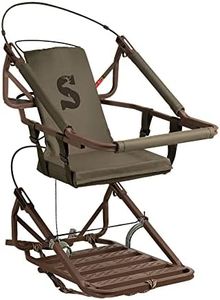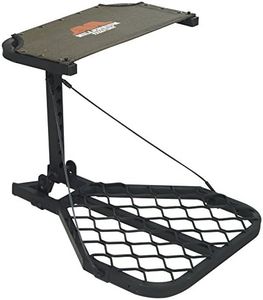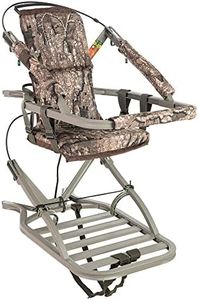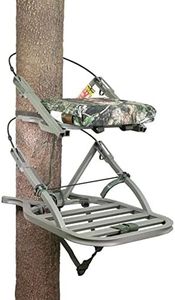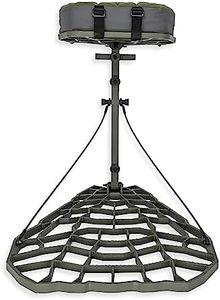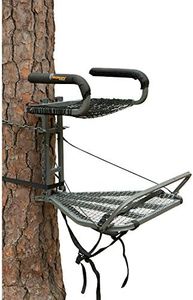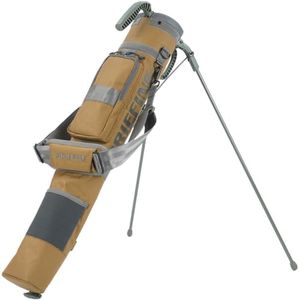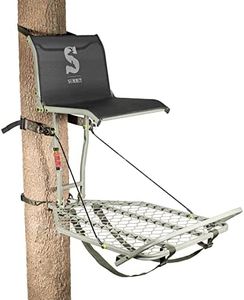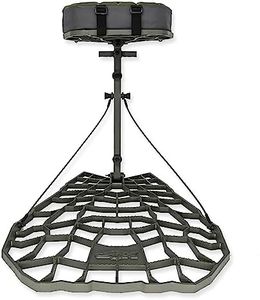We Use CookiesWe use cookies to enhance the security, performance,
functionality and for analytical and promotional activities. By continuing to browse this site you
are agreeing to our privacy policy
10 Best Climbing Stands
From leading brands and best sellers available on the web.Buying Guide for the Best Climbing Stands
Choosing the right climbing stand is important for hunters and wildlife observers who want to find an elevated and mobile vantage point in the woods. The right model should be comfortable, safe, portable, and well-suited to your physical needs and the environment where you’ll be using it. Understanding the key specs will help you decide which climbing stand will best match your goals and conditions.Weight CapacityWeight capacity refers to the maximum combined weight the stand can safely support, including both yourself and any gear you bring. It’s crucial to ensure your total weight doesn’t exceed this limit for safety and stability. Models typically range from about 250 to 350 pounds. If you’re lighter and carry minimal gear, a lower capacity may be enough, but for heavier individuals or if you bring lots of equipment, look for a higher capacity model. Always check your combined weight before choosing.
Stand WeightStand weight is the actual weight of the climbing stand itself and affects how easy it is to carry to and from your hunting spot. Lighter stands (15–20 lbs) are easier to pack for long walks but may sacrifice some comfort or stability. Heavier stands (over 25 lbs) can provide more room and comfort but might be difficult to carry over rough terrain. If mobility and ease of transport are top priorities, consider a lighter option. If you set up closer to your vehicle, you might prioritize comfort and stability over carrying weight.
Seat Comfort and AdjustabilityThe seat is where you’ll spend most of your time, so comfort and the ability to adjust its position matter. Basic seats may be foam pads, while more advanced ones have padded backs and adjustable heights. For short hunting sessions or if you tend not to sit long, a basic seat will do. For all-day hunts or if comfort is a key concern, look for a well-padded and adjustable seat to minimize fatigue and discomfort.
Platform SizePlatform size refers to the area you can stand on while in the tree. Wider and longer platforms give you more room to move around, which increases comfort—especially for larger individuals or those who like to shift position frequently. Narrow platforms save weight but can feel cramped. If you value space and stability, look for a larger platform. If portability and weight are more important, a smaller platform may be preferable.
Ease of Climbing MechanismThe climbing mechanism is how you ascend and descend the tree, usually by alternating the seat and platform sections up the trunk. Some stands have simpler, quicker systems; others may require more effort or have a learning curve. If you’re new to using climbing stands, look for models known for user-friendly mechanisms. If you’re experienced and climbing speed isn't a concern, almost any mechanism can work—the key is to choose a system you feel safe and comfortable using.
Tree CompatibilityClimbing stands work on specific tree diameters and bark types. Some are designed for straight trees only, while others can handle a bit of taper or curve. Always check the minimum and maximum tree diameter the stand can grip safely. If your hunting area has mostly slim or oddly-shaped trees, make sure the stand you choose is compatible. A mismatch here can mean you can’t use the stand where you hunt.
Noise LevelNoise level refers to how much sound the stand makes while climbing or moving in it. Stands made with quieter materials and padded parts reduce clanking and scraping, which is important in hunting to avoid startling game. If stealth is crucial in your hunts, opt for a model with noise-dampening features. For casual wildlife watching or when noise is less of a worry, this spec may be less important.
